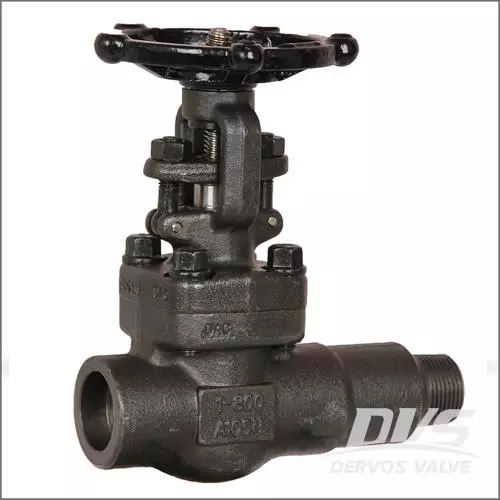Common material types of rubber seals used for forged steel valves
From the early 1950s, the United States and the former Soviet Union began the development of fluoroelastomers. The first putting fluoroelastomer into production is the VtionA and Kel-F of DuPont and 3M. After half a century of development, fluoroelastomers have developed rapidly in various aspects such as heat resistance, medium resistance, low temperature resistance and process, and formed a series of products.
Fluorine rubber has excellent heat resistance, ozone resistance and various hydraulic oil properties.
It has an operating temperature of -40 to 250 ° C in air and an operating temperature of -40 to 180 ° C in hydraulic oil. Due to the processing of fluorine rubber, the bonding and low temperature performance are inferior to those of the general rubber and the price is also expensive, so it is mostly used in high temperature medium where general rubber is not suitable, but it is not suitable for some phosphate ester solutions.
2. EPDM is a terpolymer of ethylene, propylene and a small amount of non-conjugated diene olefins.
In 1957, Italy realized the industrial production of ethylene and propylene binary copolymer rubber (diethylene propylene rubber). In 1963, DuPont of the United States added a small amount of non-conjugated cyclic diene as a third monomer to the binary ethylene propylene rubber to synthesize a low unsaturation EPDM with a double bond in the molecular chain. Since the molecular backbone is still saturated, EPDM maintains the excellent properties of diethylene glycol and at the same time achieves the purpose of vulcanization.
EPDM rubber has excellent ozone resistance and does not crack in 2430 hours in an environment with an ozone concentration of 1*10-6. It has good corrosion resistance: EPDM rubber has good stability to alcohols, acids, alkalis, oxidants, detergents, animal and vegetable oils, ketones, and certain lipids (but it is heavily swelled in petroleum-based fuel oils and hydraulic oils, and cannot work in contact with mineral oil); excellent heat resistance, can be used for a long time at -60 to 120 °C; has good water resistance and electrical insulation ability.
The original color of EPDM rubber is beige and its elasticity is excellent..
3. The polyurethane elastomer (PU) is a polymer made of a polyisocyanate and a polyether polyol or a polyester polyol or/and a small molecular polyol, a polyamine or a chain extender such as water or a crosslinking agent. In 1937, Professor Otto Bayer of Germany first discovered that polyurethanes were obtained by polyaddition of polyisocyanates with polyol compounds, and based on this, they entered industrial applications. Polyurethane elastomers have a use temperature range of -45 ° C to 110 ° C and have relatively high elasticity and strength, excellent wear resistance, oil resistance, fatigue resistance and vibration resistance within a relatively wide range of hardness. It has good anti-swelling properties especially for lubricating oil and fuel oil. Polyurethane elastomer is known as “wear proof rubber”
Polyurethane elastomers have excellent comprehensive properties and have been widely used in metallurgy, petroleum, automotive, mineral processing, water conservancy, textile, printing, medical, sports, food processing, construction and other industrial sectors.
4. Polytetrafluoroethylene (PTFE)
Polytetrafluoroethylene (abbreviated as Teflon or [PTFE, F4]), is known as / "Plastic King". It is a polymer compound made of tetrafluoroethylene. It has excellent chemical stability and corrosion resistance. It is one of the best corrosion resistance materials in the world. Except for molten metal sodium and liquid fluorine, PTFE can withstand all other chemicals; it does not change in boiling aqua regia. PTFE is widely used in various applications requiring acid and alkali resistance and organic solvents. It has excellent sealing performance, high lubrication with non-stickiness, electrical insulation and good anti-aging endurance, and excellent temperature resistance (can work for a long time from +250 ° C to -180 ° C). Teflon itself is not toxic to humans, but one of the raw materials used in the production process, perfluorooctanoic acid (PFOA), is considered to be likely to be carcinogenic.
Temperature: -20 ~ 250 ° C (-4 ~ +482 ° F), allowing quenching and rapid heat, or alternating hot and cold operation.
Pressure: -0.1~6.4Mpa (full negative pressure to 64kgf/cm2) (Full vacuum to 64kgf/cm2)
Advantage:
High temperature resistance - working temperature up to 250 °C.
Low temperature resistance - good mechanical toughness; 5% elongation even at temperatures down to -196 °C.
Corrosion resistance - It is inert to most chemicals and solvents, resistant to strong acids and alkalis, water and various organic solvents.
Weather resistant - the best aging life in plastics.
High lubricity – the lowest coefficient of friction in solid materials.
Disadvantages: Poor elasticity.
